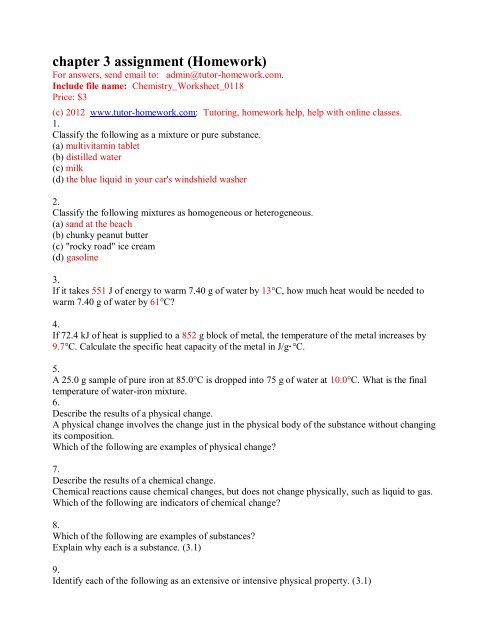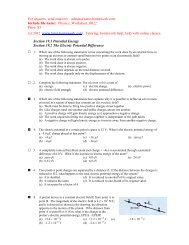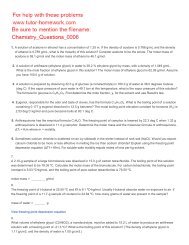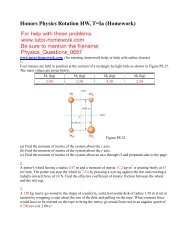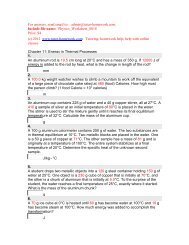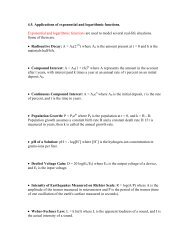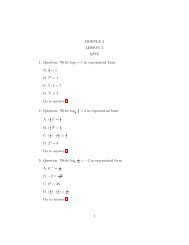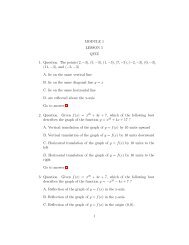chapter 3 assignment (Homework) - Tutor-Homework.com
chapter 3 assignment (Homework) - Tutor-Homework.com
chapter 3 assignment (Homework) - Tutor-Homework.com
You also want an ePaper? Increase the reach of your titles
YUMPU automatically turns print PDFs into web optimized ePapers that Google loves.
<strong>chapter</strong> 3 <strong>assignment</strong> (<strong>Homework</strong>)<br />
For answers, send email to: admin@tutor-homework.<strong>com</strong>.<br />
Include file name: Chemistry_Worksheet_0118<br />
Price: $3<br />
(c) 2012 www.tutor-homework.<strong>com</strong>: <strong>Tutor</strong>ing, homework help, help with online classes.<br />
1.<br />
Classify the following as a mixture or pure substance.<br />
(a) multivitamin tablet<br />
(b) distilled water<br />
(c) milk<br />
(d) the blue liquid in your car's windshield washer<br />
2.<br />
Classify the following mixtures as homogeneous or heterogeneous.<br />
(a) sand at the beach<br />
(b) chunky peanut butter<br />
(c) "rocky road" ice cream<br />
(d) gasoline<br />
3.<br />
If it takes 551 J of energy to warm 7.40 g of water by 13°C, how much heat would be needed to<br />
warm 7.40 g of water by 61°C?<br />
4.<br />
If 72.4 kJ of heat is supplied to a 852 g block of metal, the temperature of the metal increases by<br />
9.7°C. Calculate the specific heat capacity of the metal in J/g·°C.<br />
5.<br />
A 25.0 g sample of pure iron at 85.0°C is dropped into 75 g of water at 10.0°C. What is the final<br />
temperature of water-iron mixture.<br />
6.<br />
Describe the results of a physical change.<br />
A physical change involves the change just in the physical body of the substance without changing<br />
its <strong>com</strong>position.<br />
Which of the following are examples of physical change?<br />
7.<br />
Describe the results of a chemical change.<br />
Chemical reactions cause chemical changes, but does not change physically, such as liquid to gas.<br />
Which of the following are indicators of chemical change?<br />
8.<br />
Which of the following are examples of substances?<br />
Explain why each is a substance. (3.1)<br />
9.<br />
Identify each of the following as an extensive or intensive physical property. (3.1)
(a) melting point<br />
(b) mass<br />
(c) density<br />
(d) length<br />
10.<br />
Which of the following indicators suggest that a chemical change has probably taken place? (Select<br />
all that apply.) (3.2)<br />
11.<br />
Which of the following are characteristics of a mixture? (3.3)<br />
12.<br />
Express the following in scientific notation. (Chapter 2)<br />
(a) 6500<br />
(b) 2373<br />
(c) 0.9613<br />
(d) 759<br />
(e) 74700<br />
(f) 0.002013<br />
13.<br />
Convert 49°C to Kelvins. (Chapter 2)<br />
14.<br />
A heterogeneous mixture<br />
15.<br />
What does the metric prefix milli mean?<br />
16.<br />
How many kilometers are in 6,250,000.0 centimeters?<br />
17.<br />
The concept of ____ indicates the ability of a person to measure consistently.<br />
18.<br />
Classify the following as homogenous mixtures, heterogenous mixtures, elements or <strong>com</strong>pounds.<br />
(a) salt water<br />
(b) salad dressing<br />
(c) iron<br />
(d) water<br />
(e) shampoo


